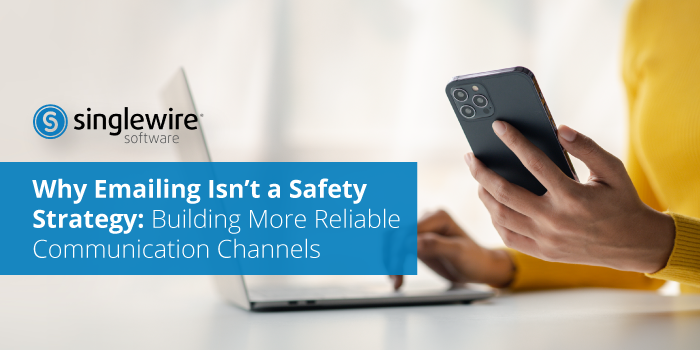Prioritizing Urgent Communications
Too often, organizations are still relying on a single, unreliable tool to get the word out: email. Whether it’s a burst pipe that needs immediate attention, a security incident that requires staff to lock down, or a weather-related closure, email is the primary way organizations notify staff and stakeholders.
Unfortunately, email is not designed for urgent, high-stakes communication. It’s a productivity tool, not a critical communication channel, and treating it like one can lead to dangerous delays, confusion, and missed alerts.
This blog explores why relying on email alone is risky, the coverage gaps it creates, and how organizations can strengthen their communication strategy to keep everyone informed during critical incidents.
The Problem with Email as an “Alert System”
Email works well for routine information, but it falls short in fast-moving situations. Common issues include:
- Delivery delays: Network congestion, spam filters, and synchronization issues can mean emails don’t arrive for minutes — or at all.
- No delivery confirmation: You can’t reliably know who received or opened a message.
- Limited reach: Mobile workers, contractors, or those without constant email access may miss alerts entirely.
- Inbox fatigue: Important messages get buried under newsletters, meeting invites, and non-urgent updates.
- Lack of urgency: An email subject line simply doesn’t cut through the noise the way a loudspeaker, text message, or push alert can.
This presents a serious challenge for organizations: if email is the only communication method during a critical event, you’re almost guaranteed to miss people.
Real-World Scenarios Where Email Falls Short
Consider these situations:
- A water main breaks after hours. Facilities need to act quickly, but custodial and maintenance staff don’t see the message until the next morning.
- A student medical emergency occurs in a hallway. The nurse’s office is emailed, but no one checks their inbox in real time.
- A weather-related closure is announced at 5:30 a.m. Emails are sent, but many staff and families don’t check email before leaving home.
- During a security incident, staff need to shelter in place immediately. Email alerts can’t deliver real-time instructions to those away from their desks.
In each case, the delay isn’t because people don’t care; it’s because the channel itself isn’t built for urgency.
Building a More Reliable Communication Strategy
Organizations need to think beyond inboxes. A strong critical communication strategy uses multiple, integrated channels to reach people wherever they are, with the urgency each situation demands.
Here’s what that can look like:
- Text and mobile push notifications for on-the-go staff and parents.
- Overhead audio announcements for immediate, site-wide attention.
- Digital signage and desktop pop-ups to reach people visually and audibly inside buildings.
- Phone calls or automated voice messages for situations requiring confirmation.
When these channels work together through a centralized communication platform, organizations can target messages by role, location, or device and ensure the right people get the right information at the right time.
Why This Matters for Organizations
Outdated communication methods often mean more manual coordination, slower response times, and higher risk exposure. Relying on email alone can create unnecessary single points of failure and leave stakeholders questioning the organization’s preparedness.
By modernizing communication strategies and moving beyond email, these organizations can:
- Increase message reliability and speed
- Reduce confusion and follow-up calls during emergencies
- Meet compliance requirements for timely notification
- Improve staff confidence in safety procedures
Practical First Steps
Upgrading your communication doesn’t have to mean overhauling everything at once. Start by:
- Auditing current communication channels: Identify where messages are sent, how they’re received, and where gaps exist.
- Layering channels strategically: Add audio alerts, text messages, mobile push notifications, desktop pop-ups and digital displays to supplement email.
- Running drills: Test how quickly messages reach different groups and adjust accordingly.
- Standardizing protocols: Ensure everyone knows how alerts will be sent — and what each type of alert means.
Close Gaps, Protect People
Email will always have a place in organizational communication — but it cannot be the backbone of your emergency notification plan. By embracing a multi-channel critical communication strategy, organizations can close dangerous coverage gaps, reduce confusion, and protect their people more effectively.
To learn more about leveraging a multi-channel communication platform, visit our InformaCast page.
